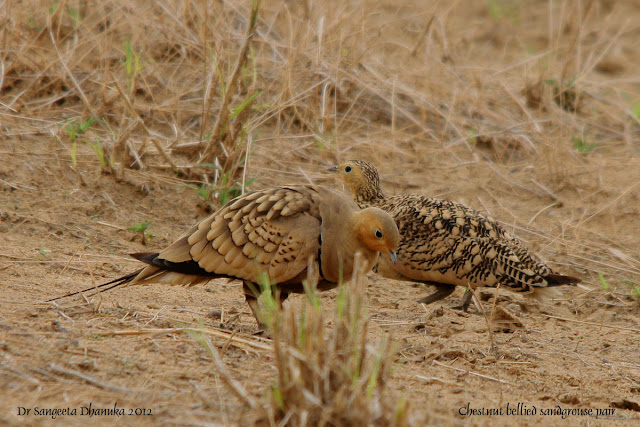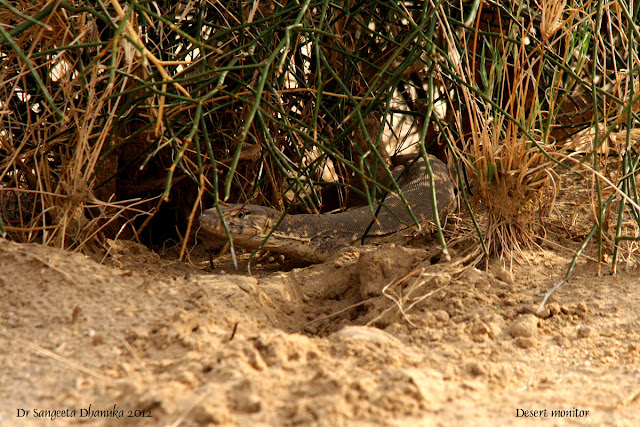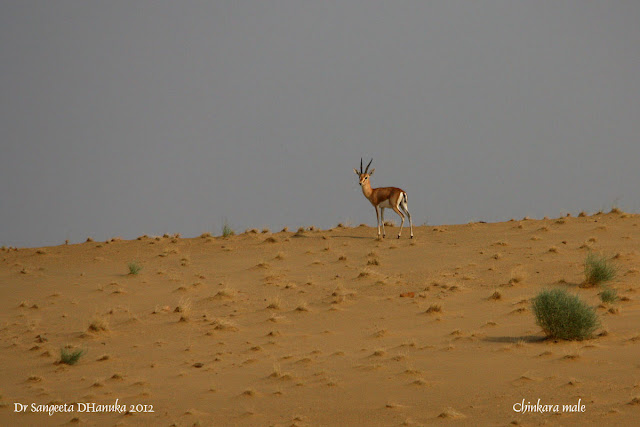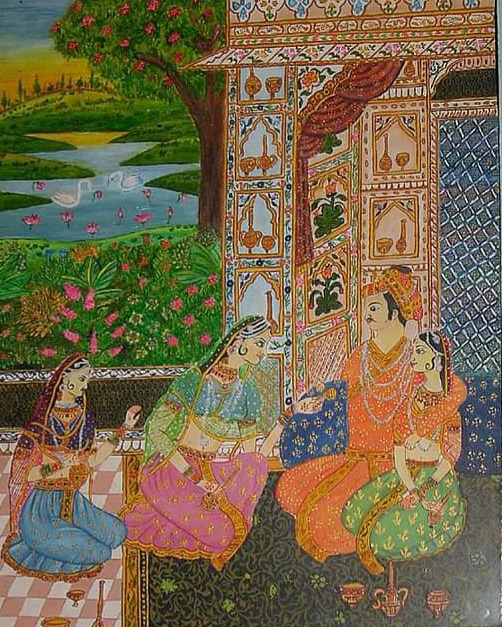In search of the Great Indian Bustard
Day - 16th Aug 2012. Place : Desert National Park, Rajasthan
More than 3000 sq km of desert, a unique ecosystem of the Thar desert,a vast expanse comprising of rocks, sand dunes, salt lake bottoms, patches of grassland...some green, some dried and golden. Supposedly one of the largest National Parks, a fragile ecosystem, home to varied forms of wildlife. And in this miles and miles of desert with its inhabitants there were only 4 more living forms of life on that day - Anjali, myself, the driver and a so-called guide.
Yes, unbelievable but true....this treasure trove of wildlife remains largely untouched by tourists and visitors. Considering the hordes of tourists and the mania surrounding other popular wildlife spots, it is a mystery that this place remains largely unexplored and not much talked about. It is of course true that we went there at a time when you wouldn't expect tourists or wildlife enthusiasts, but from what we saw of the presence (or rather absence) of any proper FD office, officials, facilities for any safaris, any signboards about the rules, dos, don't dos, no lodging boarding facilities anywhere upto Jaisalmer which is about 50-70 km away, no guides, no proper tickets or anyone to check who enters or leaves when , where, what anyone does inside the park, the local villagers completely unaware about 'birding' or rather bemused by the fact that we came to Jaisalmer to visit the Desert NP rather than the more popular monuments or temples.......all this and more were telltale signs that the place is not frequented by wildlifers. Anyone can just enter in or walk out anytime with no qts asked. Of course our so-called guide (whose job was to fence parts of the park as instructed and was supposedly an employee of the FD) was somewhat of a smart chap who tried to convince us that a permit is needed to enter, tickets etal with vehicle and guide charges etc etc, it was very obvious that it was more fiction than fact and the so-called receipt/permit not very authentic. It is another matter that we pretended to buy his story and indulged him coz we were at his mercy, else one could get lost in those 3000 kms and never find the way back.
Nevertheless, we did 3 safaris- 2 on 16th and 1 on 17th. The rains washed out the 17th completely but what we saw in 2 safaris on 16th left us with no regrets at all. The beginning wasn't good when we reached there early morn to find no camel carts to take us in the park as we had heard and our small car too risky to be taken inside for fear of getting stuck in the sand. Our hotel manager at jaisalmer had been kind enough to inform this 'guide' about our arrival and so we found him at the checkpost. Many phone calls and more than an hour later a jeep arrived and we went in finally - me thinking we have lost the safari already as it was beyond 9 am. Some common sightings followed and then suddenly we had 2 falcons closeby.
They turned out to be our luck mascots of sorts and we were suddenly having bounties.
But the reason we were there - the Great Indian Bustard, continued to elude us. The GIB is a large bird with an ostrich like appearance, this bird is among the heaviest of the flying birds. Once common on the dry plains of the Indian subcontinent, as few as 250 individuals were estimated in 2011 to survive and the species is critically endangered. Desert National Park is one of the places where the largest number out of the surviving 250 exist. Their extinction sadly seems imminent and we wanted to see them before they disappear from our planet altogether. It was nearing 10 am already and I had given up all hopes when our guide suddenly said he can see one in the far far distance. Tried much as we could, but Anjali and me couldn't. He asked us if we were willing to walk......of course we were, any distance. We just blindly and as briskly as our legs could, walked and walked behind him for about 20 min till we could see a tiny glimpse of the GIB. The trek continued till we could see it well with the binoculars but it was a good 300 mts away and no chance of pics. The barren expanse gave us no chance for a stealthy approach and everytime we got even to 200 mts of it, it just flew off. DAMN!!! Doesn't matter the guide said...... there's another one there. The drama contd and there was a time when the guy was spotting GIBs like sparrows......here there everywhere. He really had some eyes!!! Anjali and me felt very sheepish about our vision but the guy didn't give up. In one hour he had shown us 13 of them and managed some decent shots as well.
So the day continued with many raptors including 35 vultures at one spot, sandgrouses, fox, chinkaras and others.
After the noon meal and siesta at 30 km away, we headed back and were in the park again at 4.30 pm. The evening felt as if we were in Juriassic Park!!. Varieties of huge lizards cropping up everywhere.......spiny tailed, desert monitor, water monitor - the park was just full of them. We got lucky once more when we spotted the desert cat but the driver's enthusiasm took him too close and drove the cat away and I regretted missing the once in a lifetime chance of a photo of this elusive species. The desert fox then appared and assuaged my heart a little, but missing the desert cat still hurts.
We ended the day on a happy note and camped at a makeshift camping site 30 km away for the night.
We went back again in the morning all excited but the rain gods poured with a vengeance and we didn't see much except 2 female GIBs at very close quarters and some tawnies and laggar falcons scattered on the floor all over the park. How greedy one gets after a good day !!! : On any other day 2 GIBs and about 10-15 tawnies and laggars would have felt like a treat but we felt the day was a dud after what we had seen the previous day.
The Indian govt has now banned GIB photography, considering the threat to the species and their miniscule numbers - I was fortunate to have seen them at such close quarters









































































Comments
Post a Comment